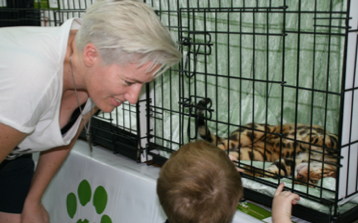Shows
Cat Show
Cat Show Halls are so much fun and can be hectic!
Exhibitors will participate in six separate, concurrently running individual show rings on Saturday and Sunday 27th and 28th April 2024.
During the day, each Judge will handle each and every kitten and cat that is entered in the cat show. Each ring is its own “mini-show” and the outcomes in one ring do not have bearing on the results in any other. Many judges will talk about the cats they are handling. Feel free to have a seat, and listen! While near the Judging Area, please do not speak loudly, or do anything that may distract the Judge, or the cat being judged.
You never know what breed may be in attendance! Ask at the check-in table if you would like to find out if a specific breed is present and competing. Explore the benching area, or take a seat in the judging area. You will see crowd favourites such as the Persian, Siamese, Bengal, British Shorthair, Burmese and American Shorthair Cat . Discover the endless variety of cats, from the Selkirk Rex to the Maine Coon.
The Touching Rule
The cats are beautiful! And what is more natural than reaching to pet a pretty cat? While enjoying the show, please do not pet the cats! Germs and viruses can easily be spread with a simple loving touch. Please ALWAYS ask the cats’ owners before reaching to pet the cat! If the owner says ‘yes”, you may be asked to disinfect your hands first.

"Cat Out!!"
If you hear cries of “Cat Out!” in the Show Pavilion it means that someone’s cat has escaped from it’s cage. Please, do not try to catch the cat if you see it; this will only scare the cat even more. Just stand still and let the owner catch the cat. If you are near an open door, please quickly and quietly close the door. Do not attempt to open any of the doors, or exit the Show Pavilion, until you hear the “Cat Caught” announcement.
What are Companion Cats and Kittens
They come in every colour, shape and size and are household pets and compete in their own division for desexed kittens and spay and neuter adults.
These Companion cats may be non – pedigreed or may possess a trait that makes them ineligible for the pedigree groups. They may be of unknown ancestry, a mixed breed, part pedigreed or a pure bred desexed cat not able to be registered in the usual group. They are judged to their own Standard, and not any other Breed Standard, as applied to pedigreed breeds. For the exhibit the most important consideration is its overall condition, wellbeing and temperament. No specific type, colour and pattern, or coat length is applicable. Friendliness, physical condition and balance are the main essentials. The exhibit should be of pleasing appearance, clean and well groomed.
Come cheer on the kitten or adult Household Pets, some of whom were rescued from local rescue programs

A Bit of Trivia
The world’s first “Championship Cat Show” was staged at London’s Crystal Palace on Thursday 13th July 1871. Although the first Crystal Palace Cat Show had been held several years previously, a Championship Cat Show was the brainchild of writer, artist, and noted cat lover, Harrison Weir who wrote breed standards against which the entries would be judged. Weir suggested the idea of a cat show to Mr Wilkinson, the Manager of the Crystal Palace which was one of London’s leading venues at the time, so this really was a high profile event! Before the day was over, the Crystal Palace Company presented Harrison Weir with a pint-size silver tankard “in recognition of his suggestions and services.”
Weir grouped the cats in different classes according to length of fur, colour, shape and build. He drew up guides for judging and called these “Standards of Excellence” or “Standards of Points”. For the first time the number of marks awarded for the colour of coat or the shape of the body were laid down. Weir’s work was later incorporated into a standard manual for cat show organisers, “Our Cats” and he is recognised as the father of the cat fancy.

